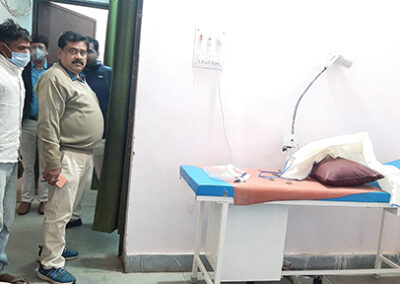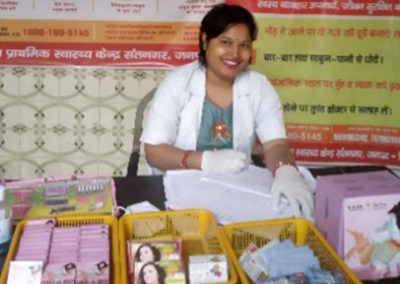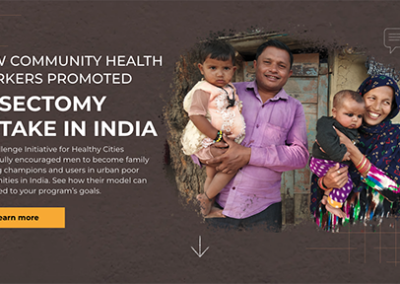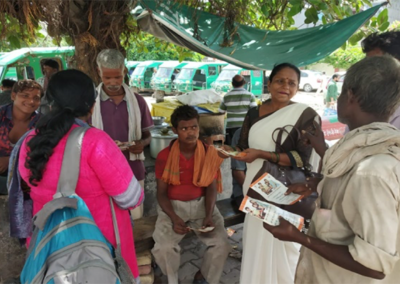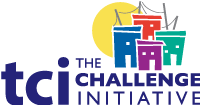India Toolkit: Demand Generation
- Home
- Help and Support
- Close
- Toolkits
- Global Toolkit
- AYSRH Toolkit
- Hub Toolkits
- Core High-Impact Practices
- Gender Essentials Mini Course
- Close
- Resource Collection
- Community of Practice
- Coaching
- Log In/Register
- My Profile
- English
Involving Men to Increase Uptake of Family Planning Services
 Purpose: This tool provides guidance on devising gender intentional and male engagement strategies to promote shared decision making for increasing the uptake of modern contraceptive methods.
Purpose: This tool provides guidance on devising gender intentional and male engagement strategies to promote shared decision making for increasing the uptake of modern contraceptive methods.
Audience:
- Additional Director/Joint Director
- General Manager-FP and Urban (National Health Mission (NHM)
- Chief Medical Officers (CMO)/Additional Chief Medical Officers (ACMO)
- Chief Medical Superintendents (CMS)
- Nodal Officers- Urban Health and Family Planning
- Divisional Urban Health Consultant (UHC)
- District Program Manager (DPM)
- Urban Health Coordinator (UHC)
- District Community Process Managers (DCPMs)/City community Process Manager
- Medical Officer In-charge (MOIC)/Staff Nurse- Urban Primary Health Center (UPHC)
- Person In-charge of Private Health Facilities
- Facility Counsellor
- NGOs/Health Partners
Background: Male participation and gender integration is crucial for ensuring accessible, inclusive and responsive family planning services that meet the needs of all community members. However, these aspects are challenging as deep-rooted societal norms have created mythical/bias/unrealistically impression that reproductive, child health, family planning are the responsibility of women. Additionally myths, misconceptions and negatively impact around male family planning methods such as non-scalpel vasectomy (NSV) . Perceptions of weakness and lack of pleasure led most men to be disinterested in this method. This reduced the number of clients for NSV procedures, which indirectly affected the providers’ ability to perform the procedure due to limited cases and opportunities to practice this skill/procedure. This is reflected in the National Family Health Survey (NFHS-V), which reveals that the modern contraceptive prevalence rate in India is 56.5%, of which male methods represent only 9.8%. Out of the 9.8%, 9.5% are condom users, while only 0.3% are NSV users. Thus, there is need to revive male methods – especially NSV – to contribute to family planning efforts and this requires a specific male engagement strategy.
The TCI tutorial below features a webinar held in May 2020 introducing the proven solution TCIHC uses in India to help local governments improve male participation in family planning.
Evidence of Effectiveness
TCI India launched the male engagement strategy in February 2019 as an 11-month demonstration project. The Male Engagement Team Leads (METLs) of TCI India in each city coached 10-12 outspoken accredited social health activists (ASHAs) to engage men in family planning counseling, which typically had not been performed in the past due to cultural and gender norms.
The coached 230 ASHAs across 20 intervention cities executed male engagement activities, explained communities about the range of family planning choices available including NSV, dispelling myths related to NSV and referring eligible clients to nearby service-delivery points. The IEC material developed by the government on family planning and NSV were used for discussing modern contraceptive methods with men. The four high-impact male engagement activities were executed – 1) Group meetings were conducted at crowded chaurahas (cross-road), 2) Engaged key influencers of the workplace to conduct meetings at small and home-based industries. 3) A detailed line-listing of rickshaw pullers associations and parking places were made where rickshaw pullers were counseled and 4) Evening meetings were conducted in the slums to counsel individuals and couples on FP methods with a special focus on NSV.
The trained public and private sector surgeons were engaged for service delivery. The tertiary facilities, government accredited private facilities and equipped urban Community/Primary Health Centers were the focal service delivery points. TCI India coached facility staff to counsel potential NSV clients on the procedure, side-effects, recovery time and follow-up.
As per TCI India PMIS data, across 20 intervention cities from February 2019-January 2020 a total of 4,080 chauraha meetings, 2332 evening meetings, 251 workplace meetings and 1712 rickshaw puller meetings were conducted by ASHAs. Around 40% of the men reached were interested in learning more about NSV and were individually counseled by ASHAs on all contraceptive methods. As per HMIS (public sector facilities) and Hausala Sajheedari government-portal (private accredited facilities) * data for the period February 2019-January 2020 a total of 3,015 NSV procedures were done across 20 intervention cities. This recorded an 87% increase in NSV adoption by men in the 20 TCI India-supported cities and a 75% increase in UP from February 2019 to January 2020, compared with the same time period from the previous year (February 2018 to January 2019). During the 11-month demonstration period, TCI India supported 27% (20) cities that contributed 81% NSV numbers in overall state performance and 73% (55) cities contributed only 19% NSV numbers. Around, 75% NSV acceptors were served by the public sector surgeons and 25% were served by the private sector empanelled surgeons.
*Refer TCI India’s Engaging with the Private Sector- Expanding the Provider Base for Meeting the Family Planning Needs of the Urban Poor appraoch to learn steps of accreditation and empanelment of private service providers.
Guidance on Promoting Shared Decision Making and Male Participation in Family Planning
The following steps have been instrumental:
1. Identify gender-sensitive trainers
Identify gender-sensitive trainers for capacity building of health staff and CHWs to promote shared decision making and increasing male participation: Gender biases can affect the quality of care provided to individuals seeking family planning services. This capacity building should include annual training of counsellors and facility staff (both male & female) on how to identify and address biases that may lead to inequitable access to services or inadequate care. The training should impart knowledge on the following:
- Using gender-neutral and gender-inclusive words/language such as people, folks and not men, women.
- Being intentional in meeting couples together during household (HH) visits to provide family planning information, method, referral; and also promote inter-spousal communication, men’s role in maternal and child care like accompanying wife during ANC/delivery/PNC visit, immunization of the child etc.
- Identify ‘gender champions’ and ‘champion Family Planning couples’ during ‘Saas bahu beta sammelan’ who can inspire others with their story. Moreover, build the capacity of ASHAs in organizing exclusive NSV happy user meetings monthly in the community with the support of ANM and other community health workers to dispel myths and motivate the community. Similarly, ASHAs with the support of ANMs can develop innovative strategies for utilizing willing NSV happy users to support government initiatives.
- Facilitating gender sensitive games and IEC that can be used by CHWs during HH visits to address gender biases, promote inclusivity, ensure informed choice, and address power dynamics that can impact access and use of services.
- Despite the limited number of male staff nurse, it is crucial to sensitize existing male staff nurses along with lab technicians about the importance of involving men in FP. Provide special training to enhance their counseling skills. Following the sensitization, allocate responsibilities to them to visit other facilities and motivate eligible men to utilize FP services.
2. Identify/create a pool of trained providers on NSV technique
Identify/create a pool of trained providers on NSV technique and Sensitize the service providers to create a welcoming environment for men: Perceptions of weakness and lack of pleasure has led most men to be disinterested in the male FP method. This has reduced the number of clients for NSV procedures, which has indirectly affected the providers’ ability to perform the procedure due to limited cases and opportunities to practice this skill/procedure. Thus, annual training calendars should be made with added requirement of refresher training each year. In accordance, organize trainings of providers on NSV method and match it with hands-on skills. Also, the availability of NSV kits as per Government of India guidelines at the facility where the surgeon is going to be deployed should be ensured.
3. Create dedicated male engagement mobilizers
For increasing demand aggregation efforts, a team of both men or women (who can be community health workers (CHW) also), who are not hesitant to talk with men about male family planning methods and are very articulate and passionate about their work should be identified for example utilize city health coordination committee (CCC) meetings to involve male field workers from National Urban Livelihood Mission’s (NULM) self-help groups in male mobilization department (read high-impact practice: Convergence of Services. These mobilizers should be oriented on gender sensitive language and counselling about the NSV method so that they can do group sensitization or one-on-one sensitization with men at the following places where they congregate and at times when they can actually pay attention to family planning discussions:
- Interventions at male congregation points like Chauraha (Cross Roads): Chauraha are places where most men gather at a fixed time daily for ‘finding odd jobs as laborers’. Labourers hold most myths about NSV as they do hard physical labour. As men congregate, mobilizers install a canopy and conduct games with family planning messaging and NSV and distribute handouts (Refer to the NSV handbill- https://nhm.gov.in/images/pdf/programmes/family-planing/IEC/print/NSV_Leaflet.pdf). Winners are announced, and one-on-one counselling is done with those people who stay back for further enquiry. As appropriate, the mobilizers refer interested men to nearest government or accredited private provider (trained in NSV) for adopting NSV method.
- Workplace Interventions: The mobilizers visit, identify and engage with men working in formal/informal industries and clarify myths surrounding NSV, wage-loss compensation, further helping them to understand the merits of NSV as a method of family planning. Post-counselling, the mobilizers refer clients to nearby facilities.
- Rickshaw Puller Intervention: This group holds some of the strongest myths related to the impact of NSV on their ability to perform their job. The steps followed in approaching them includes engagement with their associations and visiting parking points, where the mobilizers could counsel and connect them with the services.
- Evening community meetings in the slums: As men in the slums are mostly available in the evenings, this time is good for engaging men in one-on-one or group discussions on family planning methods.
4. Ensure in-clinic counseling and Fixed Day Static (FDS) service for NSV
Form a comprehensive team of both male and female staff nurses to counsel men and women. Ensure that once the client reaches the facility, they are counseled by a staff nurse/provider on all of their family planning options so that they can make an informed choice. Plan a dedicated day (FDS) exclusively for providing NSV services, each month, in health facilities equipped and offering male sterilization services. If the client agrees to sterilization method, then consent should be taken and documented. (refer to TCI India FDS approach)
5. Sensitize Adolescents and Youth (AY) on Sexual and Reproductive Health (SRH) Issues
To induce shared decision making and gender sensitivity, males must be sensitized on SRH issues and gender equality at young age. It is important to reach adolescent boys with SRH information because when boys are exposed to gender equality family planning programming, they are more likely to use contraceptive methods and support their spouse/partners in the future. The Nodal officers can utilize the CCC meetings to organize SRH and gender sensitization workshops in schools and colleges in coordination with the education department (read high-impact practice: Convergence of Services). The Nodal officer and UHC with support of MOIC should develop plan for conducting monthly orientations in nearby public sector schools/madarsa for students in 8th class and above on the topics such as, risks of pregnancy, contraceptive methods, mensural hygiene, safe and unsafe periods and plan parent orientation sessions on adolescent SRH issues.
The CMO should establish UPHCs as adolescent-friendly health clinics and initiate facility adolescent health days at UPHCs to provide accessible, equitable, comprehensive and quality health services, including SRH services to AY (to learn the steps of transforming UPHCs into AFHCs, read high-impact practice on Adolescent and Youth-Friendly Health Clinics). Organize community adolescent health days in the catchment areas of urban ASHAs with the support of ANMs and Rashtriya Kishore Swasthya Karyakram (RKSK) counselors to provide SRH information to adolescent boys and girls. In community adolescent health days, utilize simulation games like RKSK’s Kranti Bhranti, an interactive game, to spread awareness on SRH issues.
6. Utilize Media Channels to Boost Male Participation in FP
Leverage mass media platforms such as television and radio to broadcast advertisements promoting spousal communication and male contraceptive methods. Capitalize occasions like World Population Day and NSV fortnight by featuring a mobile caller tune emphasizing male engagement in FP. Additionally, ASHAs should establish WhatsApp groups for eligible couples in their respective slums, particularly those with Android phones, facilitating the exchange of concise videos, messages, and creative content on male involvement. Extend this outreach by circulating text messages through ASHAs to individuals with non-Android phones. Moreover, within existing WhatsApp groups for ASHAs and ANMs, periodically disseminate reminders of their roles and responsibilities to enhance engagement.
Roles and Responsibilities
Role |
Responsibility |
General Manager FP/Urban/ Joint Director/ Additional Director |
|
CMO |
|
CMS/Facility In-charge (in case of private facilities) |
|
Nodal Officer Family Planning |
|
Facility Counsellor |
|
Monitoring and Reviewing Outcomes
A gender sensitive male participation strategy can be monitored by including NSV, male participation in maternal and child care as a regular agenda item for discussion in the District Quality Assurance Committee (DQAC) and District Health Society (DHS) meetings and monthly meeting of Medical Officers-In-Charges’ convened by CMO. On these forums, data generated from HMIS and private sector data on NSV from Hausala Sajheedari web portal can be reviewed on the following indicators:
- Number of men accompanying wife during ANC/delivery/PNC visits
- Number of facilities providing NSV
- Number of providers trained on NSV
- Number of Chauraha meetings planned compared to the number of Chauraha meeting held
- Number of Rickshaw Puller meeting planned compared to the number of Rickshaw Puller meeting held
- Number of workplace intervention meetings planned compared to the number of workplace intervention meeting held
- Number of evening meetings in the slums planned compared to number of evening meetings held
- Number of NSV acceptors over a period of time
- Number of facilities providing NSV FDS
Further, spot checks by the CMO and the facility–in-charge of private sector should be undertaken to ensure attention to quality parameters and resolution of bottlenecks.
Monitoring the reasons for which men are screened out/postponed for service provision can provide important information on quality of care and provider barriers to services. This information can be obtained by noting the reasons for screening out/postponement in the client register.
Data Quality Assurance: Although there is a tendency to collect and report service provision from FDS together with information from routine service days, separate record keeping for a period of time is recommended for monitoring.
Cost Elements
The following cost elements are required for increasing male engagement and NSV services, which may exist in the Program Implementation Plan (PIP) of the current year but if not, they can be requested in the next year’s PIP.
| Cost Elements | FMR Code |
| Male sterilization fixed day services |
Women and Men Fixed Day Sterilization Services FMR-RCH.6.42.OOC |
| Compensation for male sterilization | FMR-RCH.6.43.DBT.01 |
| Family Planning indemnity scheme | FMR-RCH.6.47.DBT |
| Mission Parivar Vikas: Demand generation activities |
Mission Parivar Vikas FMR- RCH.6.46.OOC.03 Saas bahu beta sammelan FMR-RCH.6.46.OOC.01 Saarthi Vahan FMR-RCH.6.46.OOC.02) |
| Male sterilization fortnight IEC and Monitoring |
FMR-RCH.6.49.IEC.02 FMR-RCH.6.49.PME.2 |
* Source: NHM PIP Guideline, 2022-24
This table illustrates the manner in which cost elements are provisioned in a government PIP, thus providing guidance on where to look for elements related to a strategy such as ‘male engagement.’
Sustainability
Institutionalizing the role of mobilizers to promote shared decision making and create continuous demand for male family planning methods, and ensuring trained providers to provide these methods would sustain the male participation strategy. Also, champions can be identified among mobilizers who can be recognized in ASHA sammelans; and also acceptors can be recognized in this forum, where they can share their experience to motivate others. In addition, the most important thing to make anything sustain is ‘review’ of these activities on a monthly/quarterly/annual basis by DHS and similar authorities.
TCI APP USERS PLEASE NOTE
You will only receive CERTIFICATES by email – when earning a score above 80% – and will not be able to view or print a certificate PDF from the TCI app.
Test Your Knowledge
Earn a Certificate
Quiz Summary
0 of 5 Questions completed
Questions:
Information
You have already completed the quiz before. Hence you can not start it again.
Quiz is loading…
You must sign in or sign up to start the quiz.
You must first complete the following:
Results
Results
0 of 5 Questions answered correctly
Your time:
Time has elapsed
You have reached 0 of 0 point(s), (0)
Earned Point(s): 0 of 0, (0)
0 Essay(s) Pending (Possible Point(s): 0)
Categories
- Not categorized 0%
- 1
- 2
- 3
- 4
- 5
- Current
- Review
- Answered
- Correct
- Incorrect
-
Question 1 of 5
1. Question
Interventions to reach out to men can include:
CorrectIncorrect -
Question 2 of 5
2. Question
Combining non-scalpel vasectomy (NSV) surgeon training with fixed day static service increases the number of trained and certified surgeons and improves service access and utilization.
CorrectIncorrect -
Question 3 of 5
3. Question
Conducting a Chauraha meeting is very critical to clarify myths since most myths associated with NSV are strongly perceived by this group who do physical labor.
CorrectIncorrect -
Question 4 of 5
4. Question
How useful did you find the information and/or tools presented on this page? Please write your response in the box below using one of the following phrases: Very useful, Useful, Somewhat useful, Not useful.
Feel free to comment on why you made that choice.
-
This response will be awarded full points automatically, but it can be reviewed and adjusted after submission.
Grading can be reviewed and adjusted.Grading can be reviewed and adjusted. -
-
Question 5 of 5
5. Question
How do you intend to use the information reviewed and/or tools that you accessed?
-
This response will be awarded full points automatically, but it can be reviewed and adjusted after submission.
Grading can be reviewed and adjusted.Grading can be reviewed and adjusted. -
Demand Generation Approaches
Available Resources
- Standards & Quality Assurance in Sterilization Services (GOI, Nov. 2014)
- Reference Manual for Male Sterilization, October 2013
- Family Planning Indemnity Scheme_2nd_Edition_2016
- GO-143 on Accreditation by UP government
- GO-Mission Parivar Vikas by UP government
- Mission Parivar Guideline dated 10th November 2016
- Guidelines for Accreditation of private health facilities to provide RCH services
- Hausala Sajheedari
- NSV handbill
- Jansankhya Sthirtha Kosh guidelines (JSK Santushti)
- NHM PIP guideline for a particular financial year
- RKSK Kranti Bhranti -Interactive Game
- TCI India tool Fixed Day Static Approach to Expand Access to Quality Family Planning Services
- TCI India tool Establishing Urban Primary Facilities as Adolescent-Friendly Health Clinics to Meet the Health Needs of Adolescents and Youth
- TCI India tool Engaging with the Private Sector- Expanding the Provider Base for Meeting the Family Planning Needs of the Urban Poor
- TCI India tool Convergence of Services



